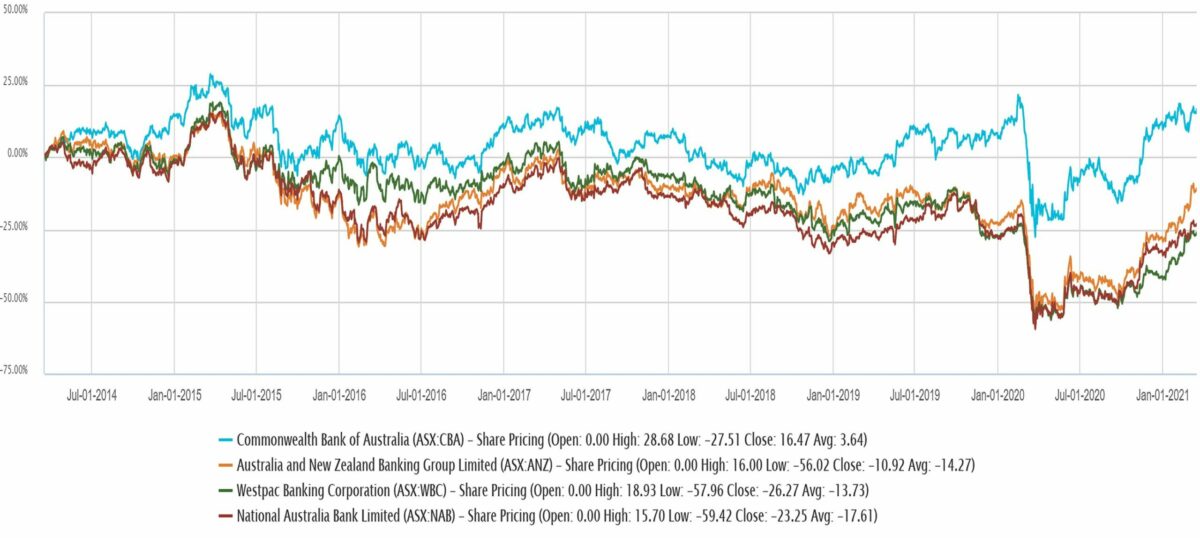Shares in the big 4 ASX banks have long been considered as the backbone of a typical investor’s balanced portfolio, often praised for being safe, reliable dividend-paying investments.
Alongside ASX banks, you might find other “blue chip” companies such as BHP Group Ltd (ASX: BHP), Wesfarmers Ltd (ASX: WES) and CSL Limited (ASX: CSL).
Indeed, while bank shares may possess these characteristics at times, I’d argue that the timing plays an important role in your potential return, i.e., Picking the right time to own such shares, depending on the underlying economic conditions.
If you bought any of the big 4 banks at their highs in 2015, your investment would still be underwater today. This doesn’t take into account dividends, however, I’d argue that if you are seeking income, it would potentially make more sense to invest in sectors with structural tailwinds working in your favour.
I believe that many of the issues that have caused banks to underperform over the last five years are still present today, which I’ll touch on later.

Why are ASX banks making a comeback?
The recovery of the financials sectors over the last five months was kickstarted when the first COVID-19 vaccination was announced by Pfizer and BioNTech.
Banks are heavily influenced by underlying economic conditions. In this case, a vaccine-led recovery meant that they could finally see an uptick in financial performance, potentially resulting from fewer loan deferrals and defaults, and more loans being issued.
Another factor that kept bank share prices down last year was the decision by the Australian Prudential Regulation Authority (APRA) to restrict dividend payments to 50% of profits. As these restrictions have eased, owning bank shares seems a far more attractive proposition than it was previously.
Finally, expectations of high growth and inflation have caused long-term bond yields to increase significantly higher. While this has caused a negative correction of tech and growth companies that have previously benefitted from low-interest rates, this has had the opposite effect on financial institutions.
The 10-year bond yield is typically used as a benchmark for consumer loans and mortgages issued by banks, but it’s important to note that higher yields haven’t trickled down into the real economy as of yet (i.e. you’re still getting next to nothing on your bank deposits).
Tough road ahead
There’s clearly a mismatch of future expectations between financial markets and central banks. Keeping in mind that banks have a tailwind in rising interest rate environments, central banks appear to be fairly certain that this won’t happen any time soon.
Reserve Bank of Australia (RBA) governor, Dr Philip Lowe has recently said that interest rates are only likely to rise when wage growth is high enough to lift inflation.
So what drives wage growth then? There are many factors, but it’s largely tied to the unemployment rate. When unemployment is low, firms must compete for workers by increasing wages, which then drives inflation.
Current wage growth is currently around 1.4% but would need to be sustainably above 3% before the inflation target band is reached. The last time wage growth was that high was in 2013.
To put that in a different perspective, unemployment would have to come down to roughly 4% from its current level of 6.4%.
Economic growth was sluggish and inflation hadn’t reached the 2.5% target for four years prior to COVID-19. Therefore, I struggle to see which potential catalyst will put banks on an upward trajectory over these next few years. The RBA remains adamant that interest rates will be kept low until 2024.
The property market continues to show strength, with values through February experiencing the highest growth rates in 17 years.
In an attempt to slow down the housing market, it may be logical to assume interest rates will be increased. However, the RBA has said that other measures can be taken, including tightening of lending laws which will likely make it harder for homebuyers to obtain a loan.
Summary
Despite these potential headwinds facing banks in the coming years, they will most likely be okay performers – not fantastic, but not terrible by any means, in my view.
The banks seem to be well provisioned from COVID-19, so it’s quite likely they will continue to distribute a stable dividend over the next few years.
But remember that you have the choice between investing in companies facing potential tailwinds, and others facing headwinds, so why make it harder for yourself?
Keep in mind that interest rate movements isn’t the only factor that will determine the success of banks, it’s just one way I’m approaching the analysis process.
Another consideration would be the valuation. What is a fair price to pay for ASX bank shares? That’s a whole different box of frogs, which you can read about here.
If you’re considering buying ASX bank shares for an income investment, it might be worth checking out other ASX dividend shares here on Rask Media.
I quite like Accent Group Ltd (ASX: AX1) and Magellan Financial Group Ltd (ASX: MFG) at the moment, which you can read about here.
CSL Limited (ASX: CSL) still has some short-term challenges from COVID-19 but is another business that’s also looking good at current levels.




